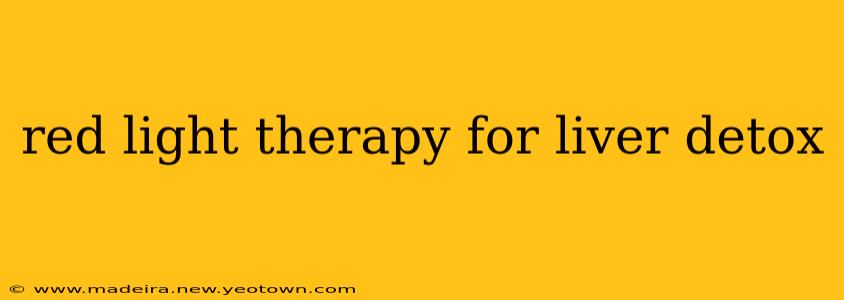The liver, our unsung hero, tirelessly works to filter toxins from our blood, metabolize nutrients, and produce essential proteins. But years of poor diet, alcohol consumption, exposure to environmental toxins, and stress can take a toll, leaving our livers sluggish and overwhelmed. Enter red light therapy (RLT), a promising non-invasive approach gaining traction as a potential aid in liver detoxification. This isn't a magic bullet, but let's explore the science and potential benefits.
Imagine this: you're feeling sluggish, bloated, and your skin isn't its usual radiant self. These could be subtle signs your liver is struggling. While RLT isn't a replacement for a healthy lifestyle or medical treatment, it might be a valuable supplementary tool.
How Does Red Light Therapy Work?
Red light therapy involves exposing the skin to low-level wavelengths of red and near-infrared (NIR) light. This light penetrates the skin, triggering cellular processes that may stimulate healing and regeneration. This works by increasing cellular energy production (ATP) and potentially reducing inflammation.
In the context of the liver, while the light doesn't directly target the liver itself, it can influence the body's overall inflammatory response and cellular function, potentially indirectly supporting liver health.
Can Red Light Therapy Help with Liver Detox?
This is where things get a little nuanced. There isn't a wealth of direct, large-scale human studies specifically on RLT and liver detoxification. Much of the evidence is based on the positive effects of RLT on inflammation, cellular repair, and overall well-being, which indirectly support liver function.
A healthy liver is better equipped to handle detoxification. RLT may contribute by:
- Reducing inflammation: Liver inflammation (hepatitis) can impair its function. RLT's anti-inflammatory properties may help mitigate this.
- Improving cellular energy: Increased ATP production can improve cellular function, potentially boosting the liver's ability to perform its detoxification tasks.
- Supporting overall health: A healthier body, achieved partly through RLT's effects, translates to a healthier liver.
It's crucial to emphasize: RLT is not a replacement for medical treatment for liver diseases like cirrhosis or hepatitis. Always consult your doctor before starting any new treatment, especially if you have a pre-existing liver condition.
Does Red Light Therapy Help with Fatty Liver Disease?
Fatty liver disease (FLD) is a common condition characterized by excessive fat accumulation in the liver. While research is ongoing, some preliminary studies suggest that RLT might offer benefits for FLD by reducing inflammation and improving liver enzyme levels. However, more robust clinical trials are needed to confirm these findings. This isn't a standalone treatment and should always be coupled with lifestyle changes like diet and exercise.
What are the Benefits of Red Light Therapy for Liver Health?
The potential benefits are largely indirect, focusing on improving the body's overall ability to support liver function:
- Reduced inflammation: Less inflammation in the body means less stress on the liver.
- Improved cellular repair: Healthier cells perform their functions more efficiently.
- Enhanced energy levels: Increased energy can support overall health, indirectly aiding liver function.
How to Use Red Light Therapy for Liver Support
There's no single "liver detox protocol" for RLT. Many people choose to treat their abdomen, as this is where the liver is located. Follow the manufacturer's instructions for your specific device. Remember that consistency is key. Results are typically seen over time with regular use.
Are There Any Side Effects of Red Light Therapy?
Generally, RLT is considered safe with minimal side effects. Some individuals may experience temporary redness or mild warmth at the treatment site. Rarely, more serious side effects may occur, so consulting a healthcare professional beforehand, especially if you have underlying conditions, is essential.
Conclusion: Red Light Therapy and Liver Health
Red light therapy holds promise as a supplementary approach to support liver health, primarily through its anti-inflammatory and cellular-regenerative effects. While not a cure-all or replacement for medical intervention, it may contribute to overall well-being and indirectly support liver function. Always prioritize a healthy lifestyle – including diet, exercise, and stress management – as the cornerstone of liver health. Consult your doctor before using RLT, especially if you have any existing liver conditions or concerns. Remember, responsible and informed use of RLT is key.

